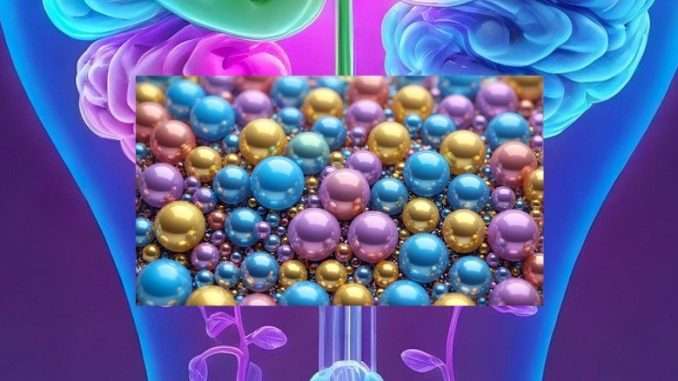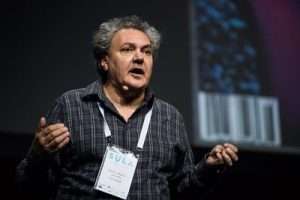
“I have always believed that art and science are intertwined, informing and inspiring each other.” — Michael Masucci, DNA Festival Santa Monica and EZTV Museum
 Michael J. Masucci is an award-winning experimental media producer, video-artist, writer, curator, educator and musician.
Michael J. Masucci is an award-winning experimental media producer, video-artist, writer, curator, educator and musician.
Masucci, was a founding member of the video art group and alternative theater/gallery space EZTV, and along with computer art historian Patric Prince, created CyberSpace Gallery, one of the world’s first art galleries dedicated to digital art.
Collaborations for which Masucci has served in a principal role have been exhibited internationally, at venues such as the Museum of Modern Art (New York), the Institute of Contemporary Art (London), and the American Film Institute (Los Angeles), on commercial television as well as in festivals, galleries conferences and universities. More.
Mobilized: DNA FESTIVAL sounds exhilarating. Let’s discuss its vision and why this is taking place?
Michael Masucci: DNA Festival is a grassroots example of DIY community building. With a micro-budget, it grew quickly to be this year’s largest festival in Santa Monica. It is a six-month long decentralized series of art exhibitions, live performances, panel discussions and screenings. It brings together members of the digital arts community, such as:
- LA ACM SIGGRAPH ,
- Bergamot Station Arts Center, the largest enclave of galleries on the West Coast,
- 18th Street Arts Center, the largest cultural non-profit organization in Santa Monica,
- Several branches of Santa Monica College,
- The EZTV Online Museum
For its inaugural years, it is specifically focused on Santa Monica’s “Cultural Corridor,” a roughly 20 block stretch of educational, gallery, performance space and tech companies. In time, we may expand to other cities, although we are proud to be bringing from Europe, three scholars on digital art history.
Additionally,I would like to thank my DNA Co-Chairs, Robert Berman and Jeff Gordon for the amazing job they have done in making this a reality.
How did your career and life pathway prepare you for where you are now?
This year marks the 45th anniversary of EZTV (not to be confused with the younger bit torrent of the same name) and it’s my 40th year curating digital art. In fact, an early digital art gallery I co-founded back in the early 1990’s, according to London’s Victoria & Albert Museum “literally put digital art on the map.” So my whole career has led to this moment.
I have always believed that art and science are intertwined, informing and inspiring each other. This year is also the massive initiative by the Getty called PST Art: Art & Science Collide!, bringing together over 70 institutions ranging from Santa Barbara to San Diego, and from Palm Springs to Santa Monica. DNA has 7 events as part of PST Art. But I don’t think that ‘art & science collide’, I think they make love.
We have discussed the need for decentralized systems. Why do you believe this is the best way forward? And, what do you think held it back for many years?
Decentralized systems will continue to proliferate and flourish. But we need to be real about what the obstacles are. The decentralized promises of web3, DAO’s (a decentralized autonomous organization,) NFT’s, and the whole blockchain revolution is forced to operate on the most centralized technology the world has ever known, namely the internet. We can never ignore that simple fact, that for the near future, decentralization relies on centralized technology. The realization of the promises of decentralization must be built despite the limitations of being hosted on. centralized framework. And I believe it can. And in time, become more the norm than the exception. But we have a ways to go.
Richard Nixon called Timothy Leary the most dangerous man in America. Why do you think he was so dangerous to Nixon; because he knew the eternal truth?
Nixon feared Leary because Leary represented freedom, and experimentation. When Leary was serving time in a maximum security prison for possession of one and a half cannabis ‘joints, if I recall correctly, (and the guy in the cell next to him was mass-murderer Charlie Mason), Leary remained free. And in one of the most amazing prison escapes, Leary escapes a maximum security federal penitentiary.
when Leary was serving time in a maximum security prison for possession of one and a half cannabis ‘joints, if I recall correctly, (and the guy in the cell next to him was mass-murderer Charlie Mason), Leary remained free. And in one of the most amazing prison escapes, Leary escapes a maximum security federal penitentiary.
You spent several years with Timothy Leary. What did you learn from this relationship? While there are so many stories, let’s discuss getting past the misinformation…
Leary was among the most generous and humble human beings I have ever known. He would say to me “I don’t want to be your leader, I want to be your cheerleader.” What an amazing sentiment. We first became friends in the strangest way.
In 1987,he had loaned an artist an Amiga Computer, with a very special (and expensive graphics card), for a computer art show I was presenting at EZTV. The computer got stolen, and we didn’t have insurance. I was broke and had no way to pay to replace it. When I told Leary, he was fine about it. He said he had heard that I was very good at making videos, and offered to exchange my video services as a way to pay down my debt. A few months later, a friend of his from Sweden was in town and needed a few hours of editing. I worked with his friend for three hours, and then Leary said my debt to him was paid, and in fact, he gave me a new Amiga computer as well. What a gracious and generous act, and what an amazing human being.
“Outside Looking In: One Last Visit With Dr. Timothy Leary
Directed by Michael J. Masucci
Possibly the last filmed interview with Dr. Timothy Leary shortly before his death. This insightful and often light-hearted portrait of the experiential pioneer were documented by his friends: EZTV’s Michael J. Masucci and Natasha Vita-More.
Footage includes archival videos from Leary’s “How to Operate Your Brain”, multiple live performances at EZTV, and videos by his collaborative partners Retinal Logic, Vertical Blanking, and Hyperdelic Media. The documentary also includes the authorized mash-up re-edit that Leary requested from Vertical Blanking, from footage taken from the Alan Rudolph documentary “Return Engagement”. Also includes live performance footage of Leary’s guests Dr. Fiorella Terenzi and Genesis P-Orridge at EZTV.
This documentary was created at the request of London’s Institute of Contemporary Art where it premiered.
He speaks of Marshall McLuhan often. If the two got together, what do you think they could have created together?
I think that Marshal McLuhan and Leary could have done an amazing lecture tour together, riffing off each other and evolving the conversation as the tour progressed.
With multinationals controlling just about every system imaginable, do you think that it istoo late to build a decentralized network? Or is this the time to do it?
I think that global corporatization, where it is largely private companies and not governments really in control, will be part of the human zeitgeist for many years. They will exist alongside decentralized systems and in many ways will affect the growth of defi, DAOs and other decentralized models, especially in more authoritarian nations.
In your own experience, where do you believe art–and creativity–emerge from?
I believe that we are essential consciousness, and that everything, good and bad, arises from our essential nature to create. I believe creativity is what it is to be human.

